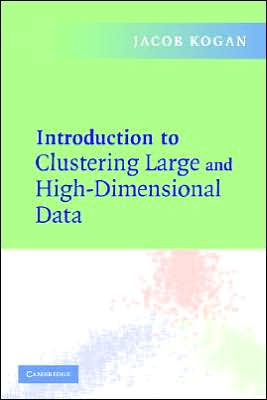

 |

|

Sold Out
Book Categories |
Foreword Michael W. Berry xi
Preface xiii
1 Introduction and motivation 1
1.1 A way to embed ASCII documents into a finite dimensional Euclidean space 3
1.2 Clustering and this book 5
1.3 Bibliographic notes 6
2 Quadratic k-means algorithm 9
2.1 Classical batch k-means algorithm 10
2.1.1 Quadratic distance and centroids 12
2.1.2 Batch k-means clustering algorithm 13
2.1.3 Batch k-means: advantages and deficiencies 14
2.2 Incremental algorithm 21
2.2.1 Quadratic functions 21
2.2.2 Incremental k-means algorithm 25
2.3 Quadratic k-means: summary 29
2.3.1 Numerical experiments with quadratic k-means 29
2.3.2 Stable partitions 31
2.3.3 Quadratic k-means 35
2.4 Spectral relaxation 37
2.5 Bibliographic notes 38
3 Birch 41
3.1 Balanced iterative reducing and clustering algorithm 41
3.2 BIRCH-like k-means 44
3.3 Bibliographic notes 49
4 Spherical k-means algorithm 51
4.1 Spherical batch k-means algorithm 51
4.1.1 Spherical batch k-means: advantages and deficiencies 53
4.1.2 Computational considerations 55
4.2 Spherical two-cluster partition of one-dimensional data 57
4.2.1 One-dimensional line vs. the unit circle 57
4.2.2 Optimal two cluster partition on the unit circle 60
4.3 Spherical batch and incremental clustering algorithms 64
4.3.1 First variation for spherical k-means 65
4.3.2 Spherical incremental iterations-computations complexity 68
4.3.3 The "ping-pong" algorithm 69
4.3.4 Quadratic and spherical k-means 71
4.4 Bibliographic notes 72
5 Linear algebra techniques 73
5.1 Two approximation problems 73
5.2 Nearest line 74
5.3 Principal directions divisive partitioning 77
5.3.1 Principal directiondivisive partitioning (PDDP) 77
5.3.2 Spherical principal directions divisive partitioning (sPDDP) 80
5.3.3 Clustering with PDDP and sPDDP 82
5.4 Largest eigenvector 87
5.4.1 Power method 88
5.4.2 An application: hubs and authorities 88
5.5 Bibliographic notes 89
6 Information theoretic clustering 91
6.1 Kullback-Leibler divergence 91
6.2 k-means with Kullback-Leibler divergence 94
6.3 Numerical experiments 96
6.4 Distance between partitions 98
6.5 Bibliographic notes 99
7 Clustering with optimization techniques 101
7.1 Optimization framework 102
7.2 Smoothing k-means algorithm 103
7.3 Convergence 109
7.4 Numerical experiments 114
7.5 Bibliographic notes 122
8 k-means clustering with divergences 125
8.1 Bregman distance 125
8.2 ϕ-divergences 128
8.3 Clustering with entropy-like distances 132
8.4 BIRCH-type clustering with entropy-like distances 135
8.5 Numerical experiments with (v, μ) k-means 140
8.6 Smoothing with entropy-like distances 144
8.7 Numerical experiments with (v, μ) smoka 146
8.8 Bibliographic notes 152
9 Assessment of clustering results 155
9.1 Internal criteria 155
9.2 External criteria 156
9.3 Bibliographic notes 160
10 Appendix: Optimization and linear algebra background 161
10.1 Eigenvalues of a symmetric matrix 161
10.2 Lagrange multipliers 163
10.3 Elements of convex analysis 164
10.3.1 Conjugate functions 166
10.3.2 Asymptotic cones 169
10.3.3 Asymptotic functions 173
10.3.4 Smoothing 176
10.4 Bibliographic notes 178
11 Solutions to selected problems 179
Bibliography 189
Index 203
Login|Complaints|Blog|Games|Digital Media|Souls|Obituary|Contact Us|FAQ
CAN'T FIND WHAT YOU'RE LOOKING FOR? CLICK HERE!!! X
 You must be logged in to add to WishlistX
 This item is in your Wish ListX
 This item is in your CollectionIntroduction to Clustering Large and High-Dimensional Data
X
 This Item is in Your InventoryIntroduction to Clustering Large and High-Dimensional Data
X
 You must be logged in to review the productsX
 X
 X

Add Introduction to Clustering Large and High-Dimensional Data, There is a growing need for a more automated system of partitioning data sets into groups, or clusters. For example, digital libraries and the World Wide Web continue to grow exponentially, the ability to find useful information increasingly depends on th, Introduction to Clustering Large and High-Dimensional Data to the inventory that you are selling on WonderClubX
 X

Add Introduction to Clustering Large and High-Dimensional Data, There is a growing need for a more automated system of partitioning data sets into groups, or clusters. For example, digital libraries and the World Wide Web continue to grow exponentially, the ability to find useful information increasingly depends on th, Introduction to Clustering Large and High-Dimensional Data to your collection on WonderClub |